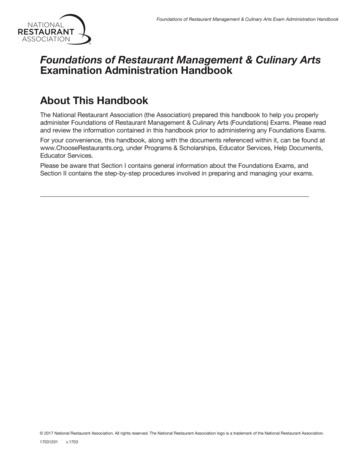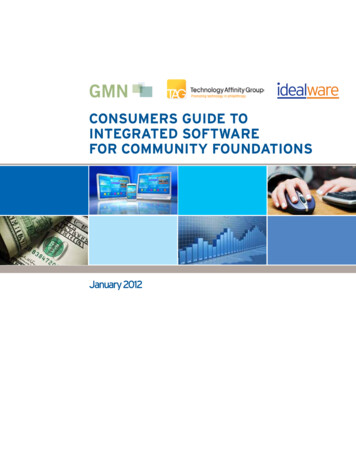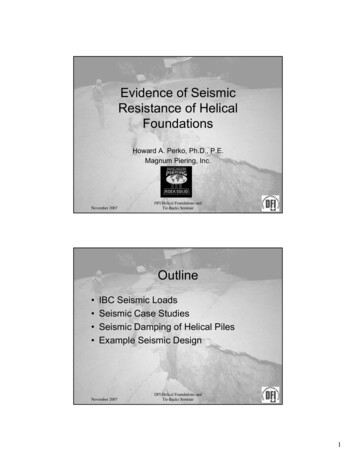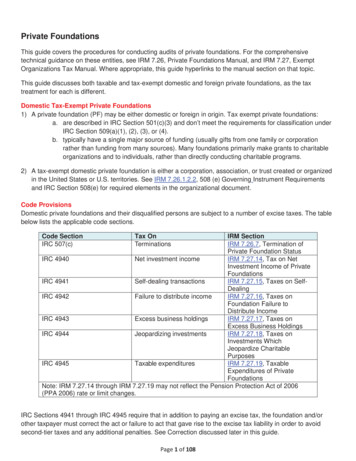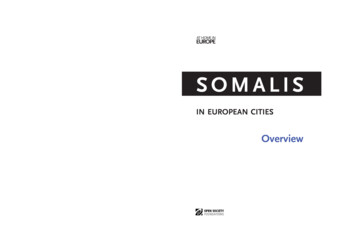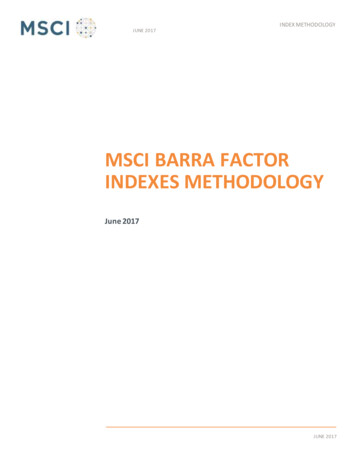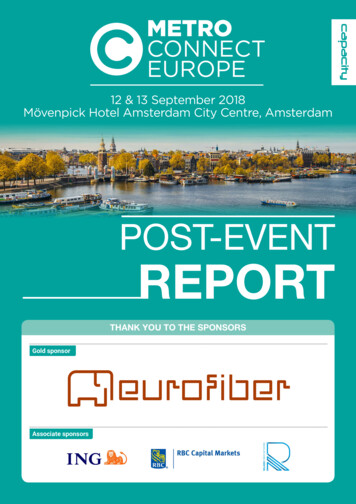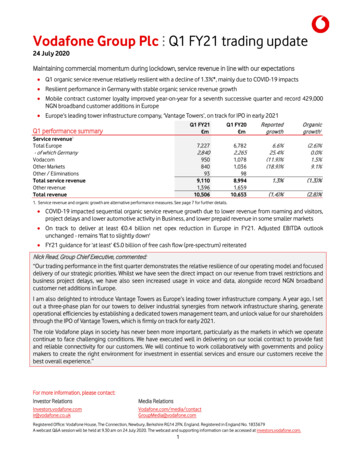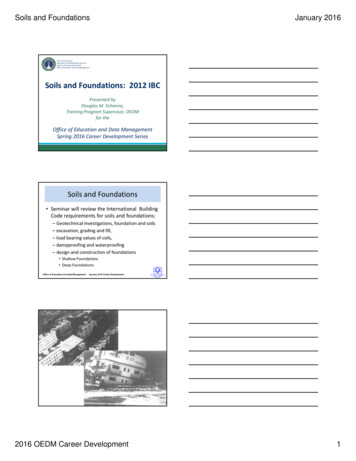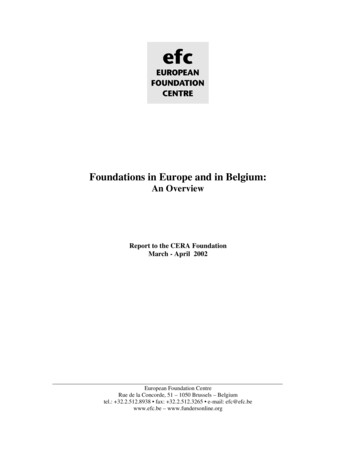
Transcription
Foundations in Europe and in Belgium:An OverviewReport to the CERA FoundationMarch - April 2002European Foundation CentreRue de la Concorde, 51 – 1050 Brussels – Belgiumtel.: 32.2.512.8938 fax: 32.2.512.3265 e-mail: efc@efc.bewww.efc.be – www.fundersonline.org
ContentsIntroductionp.31. Foundations in Europe Todayp.41.1 What Exactly is a Foundation?1.2 History of Philanthropy1.3 Current Trends1.4. Statistical Data2. Types of Foundations in Europep.112.1 Independent Foundations2.2 Corporate Foundations2.3 Governmentally-Supported Foundations2.4 Fundraising Foundations3. The Role of Corporate Citizenshipp.143.1 Definition3.2 Historical Perspective3.3 Current Trends4. Foundations in Belgium: an overviewp.164.1 Context4.2 Historical Perspective4.3 Typology of Foundations4.4 Corporate Foundations5. Legal Environmentp.185.1. Legal Framework5.2 TaxationConclusionp.21Annexesp.23European Foundation Centre - Report to the CERA Foundation – page 2
IntroductionUpon the Cera Foundation’s request, this report has been prepared by the EuropeanFoundation Centre1 (EFC) to provide a general introduction to the different types ofindependent funders active across Europe, to their work and objectives, and to the waythey operate. An overview on the development and activities of independent funders inBelgium is also included. This information has been requested in order to position theCera Foundation in the landscape of foundations in Europe, and is intended to be used byCera Foundation for internal management and public relation purposes.This document has been prepared on the basis of the information available at the EFClibrary and databases on funding in Europe. As such, it results from a compilation of themost reliable sources of information and from the experience and knowledge gained fromEFC staff in their daily transactions with EFC members. The bibliographic reference ofthe major sources is given in Annex 1.Among the first questions many people ask about independent funders is simply who arethey and what do they do? What are the different types of foundations and funders inEurope? It is recognised that most people do not understand the breadth or diversity ofthe foundation and corporate funder community in Europe. Some of them even haveserious misconceptions about what foundations and corporate funders are and how theyoperate. This document offers answers to these questions and tries to clarify the variedlandscape of foundations and corporate funders in Europe. It comprises five main parts:1. Foundations in Europe Today – Provides a snapshot of independent funders inEurope today and shows their role in modern philanthropy.2. Types of Foundations in Europe – Focuses on a part of the independent fundingcommunity, namely foundations, where they came from and the different types offoundations in Europe.3. The Role of Corporate Citizenship – Examines corporate funders, anothercomponent of the independent funding community, the long tradition of corporatecitizenship and its current trends across Europe.4. Foundations in Belgium – Shows a brief history of the development ofphilanthropy in Belgium, with a view to provide a general overview of thesituation of foundations in Belgium.5. Legal Environment – Provides an overview of the legal status of independentfunders in Belgium.Annexes have been selected to document some of the assertions in the text. They mainlyrefer to bibliography, funder typology, statistical data, and major areas of interest forfunding.1Set up in 1989, the European Foundation Centre underpins the work of independent funders active in andwith Europe.European Foundation Centre - Report to the CERA Foundation – page 3
1. Foundations in Europe TodayThe foundation landscape in Europe is richly varied, in part due to the many languagesand cultures in Europe and the different legal/fiscal environments from one nation to thenext. Foundations are an important part of the independent funding community. Theyrepresent a valuable source of income for citizens associations. But what is a foundation?How have these organisations developed to reach a stage where they find themselvesimportant forces for social change and valuable alternatives to traditional governmentsupport? Indeed, is it possible to find common ground between a British trust, a Frenchfondation, a German stiftung and a Polish fundacja, and allow for comparison betweenthese institutions?Along with the various terms for ‘foundation’ that exist across Europe, there are anumber of different foundation types. Endowed foundations exist, as do community,operating and corporate foundations. Certain foundations in Europe benefit from theproceeds of lotteries or gambling. Others may be considered to be collector/distributorfoundations, collecting funds from various sources, including the general public, tounderpin their operational or grantmaking programmes. Indeed, certain foundations inEurope are hybrids, combining several elements noted above: for example the KingBaudouin Foundation (Belgium) is an operating foundation, with an endowment,benefiting from lottery proceeds and raising funds from the general public on acontinuing basis, and with a grants programme.1.1 What Exactly is a Foundation?It is important to establish and promote a viable and generally acceptable description ofwhat a foundation is as a basis for further development of this report. The EuropeanFoundation Centre has established – through the guidance and input of its membership –the following general concept of what a foundation actually is.“Foundations: Are separately-constituted non-profit bodies Have their own dependable source of income, usually but not exclusively from anendowment or capital Have their own governing board Use their financial resources for educational, cultural, religious, research, social orother public benefit purposes Use their financial resources either by making grants to citizens associations or byoperating their own programmes and projects”Although there are numerous national differences coming from both cultural and legaldevelopments and the different uses of terminology for this area, the above conceptscover the majority of the foundations in Europe today, and distinguish them fromcitizens associations running their own programmes and other sources of nonindependent funding.European Foundation Centre - Report to the CERA Foundation – page 4
The Typology of Foundations in Europe, published by the EFC in 1997, provides acomprehensive overview of the different types of foundations that exist in Europe, andproposes to classify foundations and corporate funders into four main groups:independent foundations, corporate foundations, governmentally-supported foundations,and fundraising foundations. This publication is the result of a collaborative effort of theEFC, its members and the Orpheus Networking Centres across 37 countries, which arethe resource centres of Orpheus, the EFC information and communication programme.1.2 History of PhilanthropyEach national independent funder community has developed parallel to national socialdevelopments and thus bears the imprint of national cultures and philosophies. In someWestern countries, the roots of foundations rest in the historical philanthropy of theChurch and industrial philanthropists such as Cadbury and Guinness. In Eastern Europe,the effects of the communist philosophy and rule following the Second World War andsubsequent change in the late 1980s has meant a re-birth in, and need for the work of,independent foundations.A quick review shows that the development of foundations in many Western Protestantand Catholic countries differs greatly from those of Central and Eastern Europe duringthe 20th century.The last two decades have seen significant shifts in the attitudes and interests ofindependent funders. The European Union (EU) has grown from a small bloc of sixcountries at its formation in 1952 (known originally as the European Coal and SteelCommunity) to its current status comprising 15 Member States. The enlargement processwill further expand the EU.This growth, and the changing ways in which these countries interact, has consequentlyaffected the work of foundations. No longer are national self-interests the driving forcebehind the economic and social development of society. Instead, people and governmentsare looking beyond their borders, aware that economic, social and democratic growthrequires cooperation instead of conflict. Some foundations are also following this trendand are increasingly providing their support trans-nationally, both within and beyond thegeographical borders of Europe.1.2.1 Historical PerspectiveThe historical development of philanthropy can be broadly divided into differentreligious and political regions, with some crossing over taking place.The ChurchAcross Europe, in countries as far apart as Portugal and Finland, the roots of charitablegiving can be traced back to the Middle Ages when the Catholic Church provided a rangeof welfare and social services to the population. The religious tradition provided the basisfor the wider development of philanthropic activity by individuals and associations.These early traditions, and the leadership of the Church, were of greater importanceduring the period in the history of these and other countries when the Church lost powerand assets to the state. In Spain, for example, the Church was deprived of its assetsduring the 18th century, although these assets were used by local authorities to continuecharitable activities. The Catholic Church in Italy suffered from the ideology that helpedEuropean Foundation Centre - Report to the CERA Foundation – page 5
establish the unified Italian State, which was based upon the Napoleonic model, and wasanticlerical and centralist. In Poland, the monastic foundations of the 14th century werethe precursor of modern day foundations, which returned with the ending of thecommunist period.The Reformation dealt the Church a major blow in every country in which it took place,stripping the Church of its assets and passing them into private hands. By doing so, thispassed the mantle of charitable works onto private individuals. The Churches have sinceregained assets and today remain an important part of charitable work.The monarchiesIn some countries, the patrimony of the monarchy has played a strong role in thedevelopment of philanthropy. In Sweden King Gustav Vasa established a hospital in1533, while King Gustav Adolf made donations allowing the creation of the University ofUppsala in the 1620s. In the United Kingdom, Queen Elizabeth I passed the Statute ofCharitable Uses in 1601. This described certain causes as charitable. In Germany, royalpatrimony can be traced back to the 10th century when the illegitimate daughter ofEmperor Charlemagne reputedly established the oldest surviving foundation inGermany. The Hungarian King Stephen I established the first foundation in Hungary inthe 11th century to help with the upkeep of the Church and monasteries.The industrialistsIndustry has also had a prominent role in the wider development of philanthropy inEurope. In many cases, the industrialists of the 19th century provided their workers withaccommodation, schooling and some welfare facilities. On the whole, this earlycharitable impulse was not always entirely philanthropic, but still represented anappreciation of the responsibilities by these industrialists. Later, industrialists began toprovide local charitable support to their workers, and subsequently – in the latter years ofthe 20th century –moved out to provide support to the areas where their customers reside.The first charitiesOther countries have their own unique historical perspective on the development ofcharitable giving. In Latvia, small charitable associations active in the main cities can betraced back to the 1780s, while the Russian and Jewish communities had their own formof community philanthropy as far back as the 1850s.1.2.2 The 20th and 21st CenturiesThe 20th century saw varying fortunes for the independent funders. In Central and EasternEurope, the communist era signalled an end to the role of organised and independentphilanthropy. The state controlled almost all aspects of life, and in those countries wherethere existed a growing independent funding community, the state seized control of theirassets, or at a very minimum limited the areas in which they could act.Following the changes from 1989 onwards, there was, and still remains, a rapid growth inthe non-profit sector in many of the former communist states and, despite the economicburdens, a growing independent funding sector. Although there are few indigenousfunding foundations, numerous international donors operate in these countries and assistin the establishment of primarily operational grantseeking foundations.The independent funding communities in Western Europe have faced fewer problemsthan their Eastern counterparts in modern times. However, it is only in the past twoEuropean Foundation Centre - Report to the CERA Foundation – page 6
decades that they have begun to take their place as a small but vital part of the widerfunding community. This has evolved out of governments reducing spending on a varietyof social and welfare areas, both allowing and requiring the independent fundingcommunity to step in and offer support.Western EuropeIn Western Europe, foundations generally have an endowment on the proceeds of whichthey make grants and/or run programmes. A number of the largest foundations receivedtheir initial endowment from among Europe’s large multi-national corporations, such asThe Wellcome Trust (UK), Fondazione Cassa di Risparmio delle ProvincieLombarde (Italy) and the Bertelsmann Stiftung (Germany). Across Western Europe,many foundations run their own programmes, sometimes alongside a small grantsprogramme. There are only a small number of significant trans-frontier grantmakers,although there are many foundations that make grants at a local or regional level.Central and Eastern EuropeIn Central and Eastern Europe there has been a strong growth in fundraising foundations.These are indigenous foundations that rely on a steady flow of funding from elsewhere –usually from abroad – with which to support their programmes. Although thesefoundations do not fit into the above criteria exactly for a foundation, the special situationin the former communist states allows some leeway. These foundations distribute thesupport they receive to either their own programmes or other citizens associations, andare a part of the developing independent funding community in these states. As such theyshould be recognised as a vital part of the wider community of European foundations.Of particular note in this region are the Soros Open Society foundations. Across theregion these autonomous foundations act as major grantmakers to the citizensassociations and individual citizens in the country in which they are based. They wereestablished by the Hungarian-born financier, George Soros.1.3 Current trendsAmong the numerous and different factors which influence the foundation community, itis relevant to take note of the following trends:1.3.1 International cooperationSince the early 1990’s, there has been a real development of International cooperationbetween foundations. Many organisations and networks have been created showing thewill to share expertise and good practice among funders. This cooperation is particularlystrong thanks to several organisations, which are presented below in chronological orderof their creation: The European Foundation Centre (EFC) is a knowledge-basedmembership association of foundations and corporate funders, dedicatedto strengthening organised philanthropy in Europe and Internationally.Founded in 1989 by seven of Europe’s leading foundations, the EFC todayserves a core membership of over 200 Members, Associates andSubscribers, with a further 48,000 organisations linked through a networkof funding information and support centres in 37 countries worldwideEuropean Foundation Centre - Report to the CERA Foundation – page 7
Besides a European association, many national and regional associationshave also been created in the 1990’s (e.g. Association of CharitableFoundations in the United Kingdom or the Vereniging van Fondsen inThe Netherlands) and lately, organisations such as the Swiss FoundationsGroup, established in 2001 Most of these organisations meet now on a regular basis through theWorldwide Initiatives for Grantmaker Support (WINGS)2 Programmewhich aims to increase communication among associations of grantmakersall over the world. Formally created in January 2000, WINGS evolved outof the recognition that grantmaker support organisations needed a forum inwhich to discuss the variety of common issues related to their support ofgrantmakers worldwide The need for creating partnership is represented by several networks offoundations such as the Grantmakers East Group and other interest groups(created by the EFC), and the International Network on StrategicPhilanthropy (initiated by the Bertelsmann Stiftung)1.3.2 Accountability, transparency and effectivenessThese are the three keywords which lead the current work of innovative foundations. Onefundamental truth about successful and effective grantmaking is that it involves hardwork and that the effective grantmaking process is time-consuming and involves manysteps. However, if carefully planned, it can lead to successful and lengthy relationshipswith grantees. Foundations face a challenging and changing environment. They setpriorities to be responsive, to reach smart decisions and to make an impact – all whilehaving an eye on the future.1.3.3 From Gift Givers to Collaborative EntrepreneursMany donors are still entering the philanthropic sphere without any experience. Many arestill practicing chequebook philanthropy. However with foundations sharing goodpractices and experiences through associations and networks more and more(see above),the relationship between foundations and grant recipients is becoming mostly one ofpartnership. They work together to achieve mutually agreed objectives and the foundationmay be involved in the management of the project. The grant recipient benefits thereforefrom the expertise of the foundation staff.1.3.4 Professional DevelopmentProfessional development is very important to foundations. In order to maintain theeffectiveness of a foundation it is vital to retain a constant awareness of the humanelement that is involves. The effectiveness and efficiency of a foundation are directlydependent upon the capabilities of the staff it employs. Foundation staff fulfil a role at thecutting edge of foundation activity, with responsibilities vis-à-vis the aims and objectivesof the organisation itself, as well as individual programme(s). They are entrusted tomonitor projects on behalf of their organisation, and on behalf of those responsible for2See www.wingsweb.orgEuropean Foundation Centre - Report to the CERA Foundation – page 8
initiatives, which the organisation has elected to resource. Foundation staff are calledupon to exhibit divergent skills in an ongoing cycle from project evaluation to impactassessment. Therefore, the professional development of foundation staff is vital for anyfoundation or corporate funder. This rising issue has been discussed at several EFCAnnual General Assemblies.1.3.5 Community FoundationsAnother recent trend has been the development of community foundations (which maybeconsidered as fundraising foundations - see definition in part 3). These foundations are aformal method by which the citizens of a particular community bring together funds toimprove the quality of life in their community. They serve as vehicles to nurture, sustainand enhance informal community philanthropy. Through this, community foundationscan be valuable tools in helping local communities address new and increasing social,economic and environmental needs by mobilising and leveraging new resources, makinggrants to support local projects, and building collaborative relationships with other nonprofits, businesses and government agencies. These are currently very strong in theUnited Kingdom and are developing in other countries such as Germany and thecountries of Central and Eastern Europe. The EFC supports these initiatives throughthe Community Philanthropy Initiative (CPI) programme.In Southern Europe, Italy is the only country where, since 1999, a significant movementof community foundations has been established, and it is there that some of the lessonsand implications of doing “modern philanthropy” in a traditional context have come tolight.The first, and for the moment only, community foundation in Belgium was established inthe region of Central and South West-Flanders (“Midden en Zuid West-Vlaanderen”) inMay 2001. The region of Central and South West-Flanders comprises the regions ofKortrijk, Roeselare, Tielt and Ieper. Geographically, Flanders is situated in the Northernpart of Belgium and Dutch is the official language of the region. King BaudouinFoundation is studying the possibility of developing a similar kind of fund in theSouthern part of Belgium, French-speaking Wallonia, based on their current experiencewith a company fund, “Chimay-La Wartoise Foundation”, whose features are similar tothose of a regional fund, although in this case there is neither an attraction of diversifiedlocal donations, nor the long-term vision behind the Flemish fund in terms of endowmentbuilding.Details on both Italy and Belgium cases are provided in two case studies recentlyprepared by L. Amorim, EFC CPI Coordinator. These documents are given in annexes 3and 4.1.4. Statistical DataDue to the diversity of the statutes of foundations and the variety of legal and fiscalsystems of independent funders in Europe, it is difficult to find accurate statistical dataabout foundations in Europe. However, it is interesting to examine the recent quantitativeanalysis of the sector in 15 European countries prepared by a consortium of foundationsEuropean Foundation Centre - Report to the CERA Foundation – page 9
and academic researchers, which was published by the Bertelsmann Stiftung inFoundations in Europe Society Management and Law (2001).1.4.1 Quantitative importance of foundations in EuropeRegarding the absolute number of foundations, the study shows that this number differsgreatly among the European countries, and can vary from 30 in Ireland up to 20,000 inSweden. In Belgium, 310 foundations have been identified.The same huge variety can be found when considering the proportion of the differenttypes of foundations. The operating foundations represent the majority of theorganisations identified as foundations in most of the countries. For instance, in Spainoperating foundations represent 95% of all the foundations.In order to study more closely the size of the foundation sector by country, some relativesize indicators have been used in the Bertelsmann’s study and comprise the following:number of foundations per 100,000 population, expenditure as % of GDP, employment as% of total non-profit employment, grant disbursed as % of total non-profit sector, andassets. According to these indicators, the foundation sector is most prominent inLiechtenstein, Switzerland and Sweden.Details for 15 countries are given in annex 5 (Bertelsmann, pp 52 and 56).1.4.2 Major areas of interestMost of the activities promoted by foundations in most of the countries are in theeducation and research fields, followed by the social service field. But some exceptionsexist in France where priority is given to health, in Ireland with priority to housing anddevelopment, and in Spain with priority given to arts and culture.Details for 15 countries are given in annex 6 (Bertelsmann, p58).European Foundation Centre - Report to the CERA Foundation – page 10
2. Types of Foundations in EuropeAs stated previously, along with the many different names for foundations, there aremany different foundation types in Europe. Endowed foundations exist, as do operatingand corporate foundations. Certain foundations in Europe benefit from the proceeds oflotteries or gambling. Others are hybrids, combining several elements noted above. Forexample, a foundation may be an operating foundation, have an endowment, benefit fromlottery proceeds, and also raise funds from the general public on a continuing basis.To complement the conceptual definition of a foundation, the European FoundationCentre has developed a Typology of Foundations in Europe3, again in collaboration withits membership. This typology aims to add clarity to the diverse foundation community inEurope.As such it has defined four groups by which the EFC classifies foundations. Each grouphas a number of generic sub-categories which are presented as guidelines that nationallevel organisations working in this field can modify to suit their own particular situationand preferences.These four groups are: Independent FoundationsCorporate FoundationsGovernmentally-Supported FoundationsFundraising FoundationsIn addition, it is possible to refine the classification of the foundations belonging to thesegroups into 18 of the most common foundation types in Europe according to threeessential criteria: Source of financial resourcesComposition of Governing Board: who is in control of decision making?Approach to the distribution of financial resources2.1 Independent FoundationsIndependent foundations comprise the vast majority of foundations in Europe. There arehowever a number of sub-groups which more accurately reflect the many different typesof independent foundations. The most common types of independent foundation are thefamily-controlled and trustee-controlled foundations. The original endowmentestablishing the foundation usually comes from an individual or family donation, and itmakes grants and operates programmes on the proceeds of this. Independent foundationsalso cover prize-giving foundations, such as the Nobel Foundation, and those thatreceive funding from lottery proceeds. In both cases, a board of trustees directsgrantmaking activities. Within the definition of an independent foundation, the EFCincludes the limited duration foundations and funds as recognised in Europe.3See Annex 2.European Foundation Centre - Report to the CERA Foundation – page 11
Example of Independent foundation: The Bernard van Leer Foundation(The Netherlands):The Bernard van Leer Foundation was established in 1949. Thefoundation's income is derived from the bequest of Bernard van Leer, aDutch industrialist and philanthropist, who lived from 1883 to 1958. Hewas the founder of Royal Packaging Industries Van Leer, which presentlyis a part of Huhtamaki Van Leer, a packaging company operating in 55countries worldwide.2.2 Corporate FoundationsThe EFC recognises two types of corporate foundation. A foundation with corporateinterests is one in which the foundation’s investment portfolio includes greater than 50%of the voting shares in a company, in turn this investment constitutes more than 50% ofthe capital with which the foundation fulfils its mission. Corporate foundations areseparately constituted foundations established by a company, which depend primarily onannual support from that company for their programmes.It must be noted here that many corporations also make significant donations of goods,services and money through corporate citizenship or corporate community investmentprogrammes. Although not a part of the foundation typology, these activities are a vitalpart of the independent funding resources available for citizens associations. As such,corporate community investment is looked at in the last part of this report (The role ofcorporate citizenship).Example of Corporate foundation: Fundació 'La Caixa' (Spain):Fundació 'La Caixa' came into being as a result of the merger of theFundació Caixa de Pensions and Fundació Caixa de Barcelona. It is a nonprofit organisation dedicated to serving society. The foundation is fundedby the Caixa d'Estalvis i Pensions de Barcelona which, as a savings bankunder Spanish law, may apply approximately 50% of its profits to sociocultural activities.2.3 Governmentally-supported FoundationsTwo types of governmentally-supported foundations are currently a part of the EFCTypology. Governmental foundations include national, intergovernmental andsupranational governed foundations. The common factors for these are that thegovernment body that established the foundation controls the key positions of thetrustees, although it may include trustees from outside the government itself. Fundinggenerally comes directly from the government although other sources of income may besought. Political foundations, the second type, are not common in Europe. Thesefoundations primarily exist in Germany. Usually affiliated with a political party, theirprogrammes reflect the interests and philosophies of the party.European Foundation Centre - Report to the CERA Foundation – page 12
Example of governmentally-supported foundation: The WestminsterFoundation for Democracy (United Kingdom):The Westminster Foundation for Democracy was established by RoyalPrerogative. The three main political parties in Britain are eachrepresented on the Board of Governors, and appointed by the Secretary ofState for Foreign and Commonwealth Affairs after consulting the parties.There is also a representative of the smaller political parties, as well asnon-party figures drawn from business, trade unions, the academic world,and the non-governmental sector.2.4 Fundraising foundationsAlthough many foundations seek matching support for particular programmes or theirgrantmaking activities, this term refers primarily to foundations which are in a process oftransition where they are attempting to establish their own assets and require a continualflow
traced back to the 1780s, while the Russian and Jewish communities had their own form of community philanthropy as far back as the 1850s. 1.2.2 The 20 th and 21 st Centuries The 20 th century saw varying fortunes for the independent funders. In Central and Eastern Europe, the communist era signalled an end to the role of organised and independent
